by Katherine Palthey
(click on photos to enlarge image)
MARIE ANTOINETTE’S SECOND NECESSAIRE
- PART 1 -
SOLVING A 200 YEARS OLD MYSTERY...
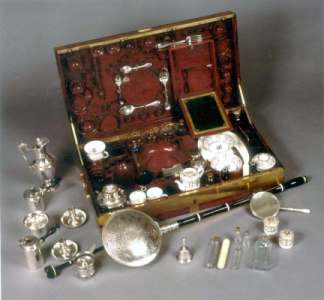 |
One of the most famous
Necessaires in France belonged to the Queen of France,
Marie Antoinette (1755-1793), and is displayed in the
International Perfume Museum of Grasse.
The IPM of Grasse recently underwent major renovation
and has reopened with over 50,000 objects in its
collection. It is organized into 5 sections, each
dedicated to a different theme and country tracing back
over the last 4000 years.
The Museum covers every aspect of the history of
fragrance, materials, manufacturing, industry, business
and design, and is nestled in the luxury perfume capital
of Grasse.
Marie Antoinette's second travelling case was a perfect
match to their existing collection of necessaires, and
was successfully purchased at auction in 1985 for almost
600,000 F.
This rare acquisition includes over 50 extraordinary
items rich in detail and history. But what impressed me
the most was the warm welcome I received when
researching the provenance and details of the
hallmarking on the pieces.
Curators Chloé Fargier and Christelle Aulagner were of
the utmost value in researching MA's travelling case.
Their assistance in the documentary department and
during the private examination of the precious objects
in the necessaire was extraordinary!
|
HISTORY OF "NECESSAIRES" In France
"Necessaires" have existed since the 14th century but they
were referred to as "boxes" or "cases" rather than what we refer
to today as necessaries. Proof in France of the oldest
"necessaire" was in 1387 with King Charles VI's toiletry case
including 3 combs, a brush and a mirror. By the 15th century it
was the nobles that enclosed toiletries and objects into small
travelling boxes, and at this time we started seeing the
introduction of decorations including bone, ivory, amber brushes
and gilded mirrors.
By 1538 Parisian Silversmith Jean Cousin supplied François 1st
with a box including 3 ebony combs, mirror, scissors, and a
brush to clean the combs. Each piece was delicately gilded and
incrusted with rubies and turquoise stones. On the cover of the
case was a clock embellished with a large sapphire.
By the 17th century we see the terms: "cassette de nuit" (night
cases) for toiletries. In addition to the toiletries, these
boxes now contained water basins, plates, cups, pitchers,
bottles, candlesticks and other daily items needed when
travelling. It wasn't until 1718 that the term "necessaire" was
used in a letter from the Duchesse d’Orleans: when she referred
to one of her belongings: "a small case or necessaire where we
have everything to have tea, coffee and chocolate milk in gold
and enamel."
After this time, France began to see the most expensive and
elaborate necessaries made for every fashionable activity such
as sewing, drawing, writing smoking, scientific use, etc. By the
time Marie Antoinette reached Versailles in the 1780’s, these
different uses were combined in one single set, resulting in
enormous travelling “necessaries”. The French at this time had
become world masters of this art as shown by the luxury items
and prestigious accessories made in gold, silver, crystal and
porcelain. Some of the items were miniaturized and everything
was made with the finest workmanship requiring several different
manufacturers such as goldsmiths, ivory turners, ebony carvers,
upholsters and craftsmen in porcelain and wood.
MARIE ANTOINETTE'S NECESSAIRE: THE SECRET DUPLICATE
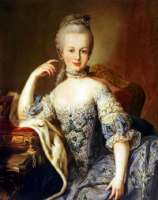
Marie Antoinette
|
According to several
sources including Madame Campan's memoirs, a
duplicate travelling case was ordered by the Queen
in April 1791 for her sister Maria Christina,
Duchess of Teschen of the Austrian Netherlands. At
this time in France under Louis XVI reign, the King
and Queen were losing popularity, forced to leave
Versailles (October 1989) and were since under house
arrest in the Tuileries in Paris. They were
constantly watched, threatened and ultimately wanted
to escape. The real story was that Marie-Antoinette
(MA) originally wanted to send her own necessaire to
her sisters in the Netherlands as she apparently
could not live without this luxury. Madame Campan
(her confident and most important first attendant),
had advised her that if she sent her own necessaire
in advance, the public would realize that she indeed
is planning to flee. Mme Campan convinced her not to
take this risk, so Marie Antoinette decided instead
to order a copy of her original case under the
presumption that it would be a gift for her sister
and that she would bring it to her in Brussels.
After announcing this loud enough in front of the
guards, this eliminated most suspicions... but as we
know not all...
|
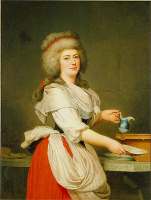
Madame Campan
|
The Queen ordered the second travelling case in April 1791
from the same Royal Cabinet-maker Palma and Silversmith
Jean-Pierre Charpenat both based in Paris. However, in May when
MA realized she may flee at any moment, this "gift" for her
sister was not ready and would take a few more weeks. Not
wanting to wait, MA announced that she would just send her own
case as her sister was very impatient. Her original case was
cleaned out and sent in mid-May to her sister Christina in the
Netherlands. In 1794 it went to her brother in Italy (Milano
hallmarks) before finally returning to France during the early
19th century. Records show it was subsequently purchased by the
Louvre in 1955 for 1,4 million francs. It is this original case
that is displayed in the Louvre today.
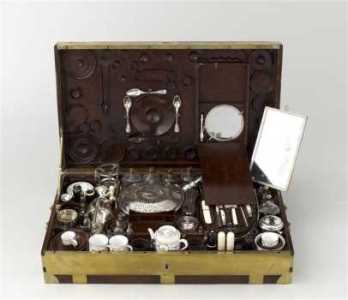
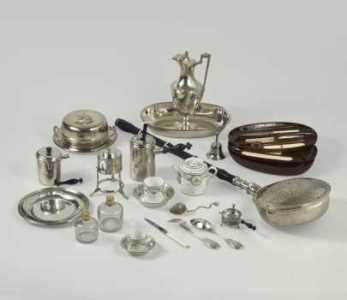
|
Louvre Museum: Marie
Antoinette's original necessaire
|
PROVENANCE OF MARIE ANTOINETTE SECOND CASE
Researching the provenance of Marie Antoinette’s duplicate
travelling case has proven extremely difficult. On June 20th
1791, Marie Antoinette and her family did escape, but were
captured at Varennes and brought back to the Tuileries in Paris.
We do have evidence that states MA brought along a large
necessaire when escaping- one of the very reasons the Berline
carriage was so incredibly heavy and slow. The real question is
whether or not the duplicate case was finished at the last
minute and MA brought it with her as well. MA did have several
necessaries, but as pictured below, this is really a very close
copy of her original case. During their escape at one of the
Post stops in Chaintrix, MA gave out two silver handled bowls
"écuelles" to Mr. Lagny, the Postmaster who welcomed them and
helped them with changing their horses. What we do know is that
after the capture and return of Varennes, most of MA's
belongings were then seized and put into the Royal Mobilier. The
rest of her belongings were stored in the Royal Mobilier when
she was transferred (empty-handed!) to the Temple in August of
1792. Royal documents prove that one particular item Number
94.50, "The Queen's travelling case", was removed from the
Mobilier Royal on 12/17/1794 to be brought to the Monnaie for
melting down. However, there has never been a trace of this case
ever entering the Monnaie or of its melting down.
After this point, we lose its trace until 1955 when the Louvre
presented MA's original necessaire. The existence of a second
identical necessaire was known, and rumors started spreading in
Paris of the value of this second case. It wasn't known for sure
until 1985 when the duplicate case was stopped at customs from
leaving France. The previous owner, Mrs Carteault, tried
exporting the case but it was stopped and quarantined. Mr
Carteault wanted it back in France and. after legal action, the
Ministry of Culture decided to prohibit this case from ever
leaving France. This limited any lucrative international buyers
and when Mr Carteault put his case up for auction in 1985,
Grasse saw the interest to invest. Grasse wanted to tie this
into their existing collection of luxury cases. Being of such
high value, the Ministry of Culture helped Grasse to purchase
this by pre-emption (a legal right in France to purchase special
items over any last bids) Grasse paid: 150,000F and Ministry of
Culture 421,362F.
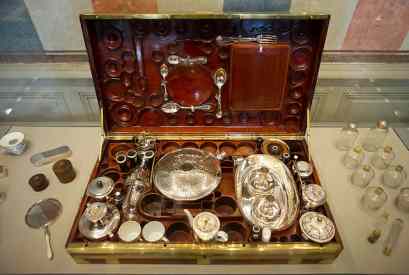
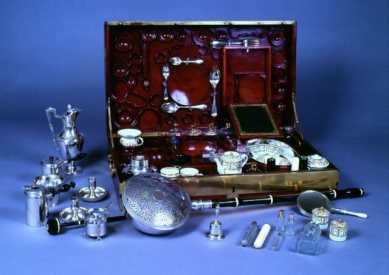
|
Marie Antoinette's
Necessaire: Grasse Museum
|
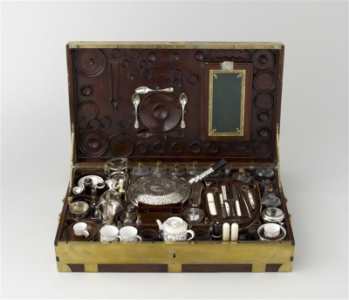
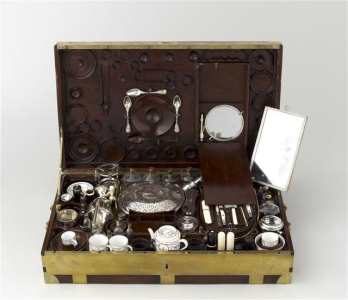
|
Marie Antoinette's
Necessaire: Louvre Museum
|
What is important to understand here is that when comparing
the content of the second case to the case that left the royal
Warehouse in 1794 - it's evident these are the same case. Then
comparing the case to the Louvre's case, it becomes obvious that
this must be the mysterious duplicate case the Queen ordered. In
comparing the photos above, we can definitely see their
resemblance in size, objects and manufacture details. They have
items made at the same time by the royal silversmith Jean Pierre
Charpenat and by the royal cabinet-maker Jacques Philippe Palma.
The inside design of the two cases is remarkably similar and
hold intricate compartments for over 150 items.
This second necessaire in Grasse have some explicable
differences: the signatures on the items and on the outside case
aren't those of MA, understandably if it was a gift for her
sister. Also, there are several very small pieces missing, which
knowing the pillaging amount even at the royal level can be
explained. The sterling "ècuelle" two handled bowl with cover
compartment (Grasse, front left) has a later replacement, which
can be justified by the fact that the original piece was given
out as a gift during the royal family escape to Varennes.
MA's second travelling
case was indeed ordered in 1791 but had silver
pieces made in Paris from 1787 to 1791. It was
handmade by the Royal Cabinet-maker Palma in veined
mahogany from Cuba with gilded brass hinges and
corners. The locking system is a complex two turn
system with a cloverleaf shaped key which latches
down in 4 places. It includes over 50 items such as
desk accessories, glasses and bottles, silver
cutlery, porcelain tableware, candlesticks, bed
warmer, coffee, tea and chocolate pots and their
spirit burner.
It measures 77x44x16,5 cm (30”x17”x6,5”) and weighs
over 40 kilos (100 pounds). There are no official
signatures or armories on this case as it was
destined to be a gift to MA's sister. Concerning
just the sterling pieces, most hallmarks are of the
silversmith Jean Pierre Charpenat, which coincides
with the inscription outside of the travelling case:
"PALMA. EBENISTE ET FAISEUR DE NECESSAIRE. VEILLE
RUE DU TEMPLE. EN FACE DU CY-DEVANT PALAIS CARDINAL.
No. 722. FAIT TOUT CE QUI CONCERNE L'EBERIE A PARIS"
(although Jean Pierre Charpenat's address is
different from that on the Louvres' case, the
explanation is simple: Paris in 1790 changed the
numbers on the buildings from 34 to 722. Based on
this address, JP Charpenat did create this case in
1791 for the Queen).
Just to note: it takes over 2 1/2 hours just to
disassemble in the Grasse Museum each intricate
compartment and then remove and reassemble the items
for display!!!
|
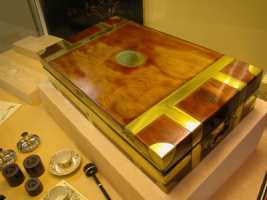
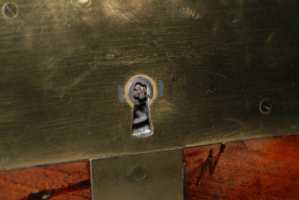
|
EXAMINATION OF HALLMARKS
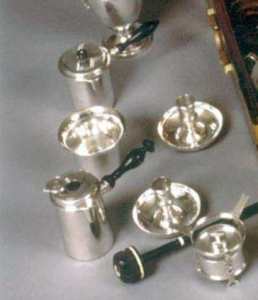
|
Three of the most
interesting pieces in the Queens Necessaire are the
Chocolate Pot ("Chocolatière"), the Spirit Burner ("Réchaud
à vin") and its fitted Toddy Beaker ("Goblet à
Bouillon").
Rare by their size and quality of workmanship each
are presented below.
|
CHOCOLATE POT
The Chocolate Pot has a removable cover engraved in circular
forms; with the center hole and its pivoting cover for receiving
the "moussoir" stirring wand. The pouring handle is removable
and screws into the side at a 90° angle. The handle has a left
hand thread on the ferrule so that when pouring it doesn't
loosen or unscrew. The stirring wand unscrews into 3 individual
pieces for storage. Both the stirring wand and handle are
handmade from ebony and ivory. This chocolatière set facilitated
the stirring, frothing and serving of hot chocolate. It stands
11.8 cm high, 7,2 cm wide, weighs 355 grams and fits neatly over
the spirit burner for warming.
HALLMARKS
In examining the "Chocolatière" three hallmarks are present:
1. "JPC": Makers mark: Jean Pierre Charpenat, Paris Royal
Ebeniste specializing in custom made necessaries for the Royal
Families, 1782 to 1804
2. "A Crowned": Paris Charge for large silvers 1783 to 1789
under Tax Farmer Henri Clavel's term. (note that starting in
1791 in France, the Tax Farmers were abolished, so not all the
pieces including this one have their proper countermarks)
3. "P Crowned": Paris Community Mark 1787 for standard of
fineness 950/1000.
SPIRIT BURNER
The Spirit Burner serves as a heater for wine, water, tea,
coffee, chocolate milk and any sort of small liquids during
travelling. It uses a type of alcohol inside the burner for
heating and stands on three legs with a neck to fit both the
chocolatière and the hot liquid pot. Inside the top ring, we
note three tiny L shaped hooks where these containers are placed
onto snugly. The burner handle unscrews like the chocolatière
and is also in turned ebony and ivory. The stand and integrated
burner measure 8 cm high and weighs 240 grams. The Toddy Beaker
that fits on this burner has a similar ebony turned handle but
the cover is finished with an ebony carved finial. The beaker
measures 11 cm high and weighs 254 grams. When the beaker or the
chocolatière is placed on top of the spirit burner the ensemble
only measures about 18 cm high – or a little over 7 inches!
HALLMARKS
The hallmarks are the same as the "Chocolatière", but in
addition to the above noted three, 4 others are found on both
the spirit burner stand and the beaker:
4. Paris Charge for small silvers 950/1000: 1783-9 under
Henri Clavel, LL intertwined
5. Paris smalls countermark 1786-9: eagles head facing left (also
inside of beaker lid and again on each smaller piece like the
burner snuffer and the twist off screw)
6. Minerve 1st on inside collar of burner container, and again
on the outside top ring of the spirit burner stand (Silver
950/1000 after 1838: is not unusual to see several more recent
hallmarks after the revolution as proof of the items quality or
for resell)
7. countermark "fly" on beaker bottom and also on burner stand.
This was an unusual hallmark under Henri Clavel, the most
frequent countermark for small silvers being the eagles head or
birds head facing left. This exact "fly" countermark was not
found in my Beuque Dictionary of 1925 but rather in the Tardy
Dictionary of 1985, page 131..
SOURCES:
Ms Christelle Aulagner and Ms Chloé Fargier; The International
Perfume Museum of Grasse; Interviews, documentation,
examinations and photos.
With immense gratitude, this research could never have
been done alone!
- Parfum et Flacons au XVIII Siècles, Musée International de la
Parfumerie, Grasse, 8 Place du Cours
- Etats des Objets Renfermer dans le Nécessaire de la Cidevant
Reine, pour être Portes à la Monnoye, Archives Nationals, 02
410, pg 139-141
- Descriptif du Nécessaire de Marie Antoinette, Mr Corteault,
1985
- Indispensables Nécessaires, Reunion des Musees Nationaux,
Paris 2007, 49 rue Etienne-Marcel, 75001, Paris
- International Hallmarks on Silver, Tardy, 6 rue Milton, 75009,
Paris 1985
- Dictionnaire des Poinçons, Emile Beuque , Imprimerie Courtois,
11 rue Rébéval, 1925
- Le Nécessaire No. 107 - Catalogue de Vente le 14 juin, 1985,
MM Monnaie, Serret et Portier, Cabinet de Fommervault Experts,
17 rue Drouot, 75009 Paris
- Marie Antoinette, Reunion des Musees nationaux Paris 2008, 49
rue Etienne-marcel, 75001, Paris
- Memoirs of Marie Antoinette, Madame Campan, Book 6, Chapter V,
http://www.authorama.com/memoirs-of-marie-antoinette
- La Drame de Varennes June 1791, G. Lenotre, Librairie
Académique Perrin & Cie
- Les Dernieres Jours de Marie Antoinette, Frantz Funck-Bretano,
http://biblisem.net/narratuo/foncdjma.htm
- Cartel Detailler Coffret Marie Antoinette, Musée de Grasse,
Service des Ateliers, 2011 Musées de Grasse, website:
http://www.museesdegrasse.com/micromuseegrasse/fiche/94507AC
- Les Grands Orfèvres de Louis XIII à Charles X, Claude Frégnac,
Librairie Hachette, 1965
Katherine Palthey
- 2013 -
images of Marie Antoinette's necessaire are copyright of International Perfume Museum of Grasse
|
|
|

